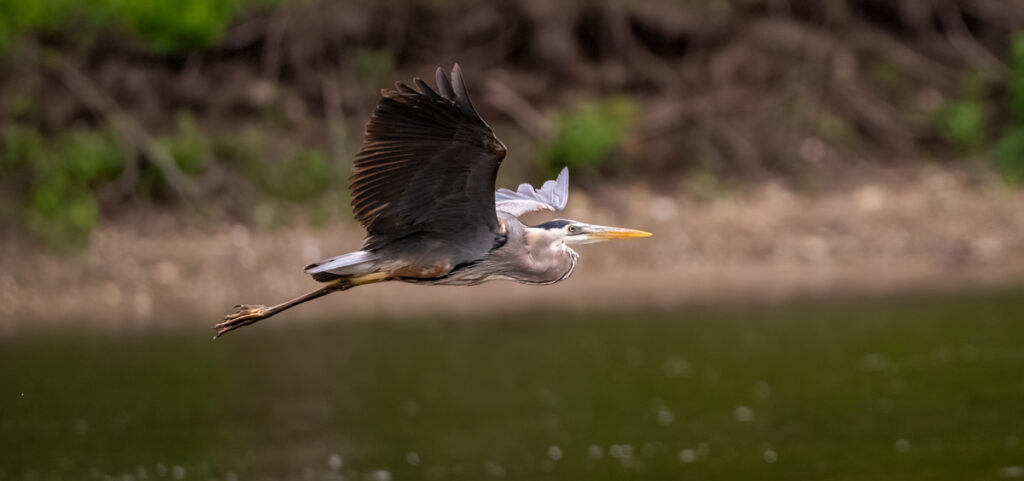
Wetland habitats such as coastal areas, lakes, marshes, and rivers provide vitally important resources for thousands of species, ranging from the microscopic to some of the largest on the planet, as well as playing crucial roles in the global water, oxygen, nitrogen, and sulfur cycles that sustain all life. A birder’s paradise, wetlands host one family of birds whose members share many similarities but are also marked by unique traits that set them apart from each other and other water birds.

Wading birds are considered indicator species by scientists because their presence, population size, and behavior reflect the overall health of wetland ecosystems. A decline in their numbers often signals problems like habitat loss, pollution, or changes in water quality. As wading birds forage, their movements stir up sediment, which helps prevent the overgrowth of algae and maintains clear water conditions. This in turn allows sunlight to penetrate deeper into the water, supporting this aquatic vegetation growth, that serves as a habitat and food source for so many other species.
Herons, egrets, and bitterns stand out as some of the most distinctive and fascinating waders who all belong to the family Ardeidae. Their elegant forms, hunting prowess, and complex nesting behaviors make them a true spectacle for birdwatchers and nature enthusiasts alike.
An obvious characteristic is their sharp, often long, and dagger-like bill, and their graceful, elongated necks. In combination, these assets become formidable weaponry when hunting fish, amphibians, and insects. Unlike other water birds that often dive or swim to catch their prey, these waders employ a different hunting style. They are known for their patience and precision, often remaining still for long periods, waiting for the perfect moment to strike. This “stand and wait” technique allows them to ambush prey with incredible speed.

Herons are perhaps the most well-known and seen of this group. The Great Blue Heron is one of the largest heron species and is widespread in North America. Standing at up to four feet tall, with a wingspan of around six feet, this bird is an instantly recognizable sight. It is often seen along the shores of lakes, rivers, and marshes, as it hunts for fish and small mammals. The bird’s distinctive slow, deliberate movements make it an impressive hunter, and give it an almost alien aura as it surveys the watery depths for the slightest of movements. The largest heron of them all, the aptly named Goliath heron, is found in Asia and sub-Saharan African countries.
Night herons are a sub-group of the same family, of course, but—as evidenced by the name—prefer to hunt under the cover of fading light and darkness. They are considerably stockier than other herons and with shorter legs, but their hunting technique is no less diminished by these adaptations. One thing to look for is the red tint to their eyes, that helps them see in the dead of night.

Egrets are closely related to herons and share many of their traits but are often more slender and adorned with plumes, particularly during the breeding season. The Great Egret has striking white plumage and that easily identifiable long, s-curved neck. A similar species, the Snowy egret, is a much smaller bird, whose numbers were decimated in the 19th century for their beautiful plumes, but thankfully due to much needed protections, they are now more numerous than ever and can be seen your-round on southern Pacific coastlines and parts of Florida. Snowy egrets use a slightly different hunting style, by stirring up the water with its feet to flush out prey, then swiftly snatching it up.

Last but in no way least, bitterns are the most elusive members of this group, often difficult to spot due to their excellent camouflage and secretive nature. The American Bittern is a prime example, known for its streaked brown plumage that blends seamlessly with the reeds and cattails of its marshy habitat. When threatened, the American Bittern will often freeze with its beak pointing upwards, mimicking the reeds around it, making it almost invisible to predators and observers alike, unless it strikes the pose out in grassland like this one Owen captured at the Montrose Point Bird Sanctuary, Illinois. These birds are solitary hunters, feeding primarily on fish, amphibians, and insects. The Least Bittern is the smallest of the bitterns, but despite its small size, it is a skilled hunter, capable of squeezing through dense reeds to catch its prey.
To observe these waders in the wild, it’s essential to visit the right habitats, of course, but picking your time of the day is the most crucial element. Early morning or late evening is often the best time to see herons and egrets, while dusk is ideal for spotting the more elusive bitterns and night herons. Patience is key; these birds are masters of stealth and may require time to reveal themselves. Keep an eye out for movement in the water or reeds for almost imperceptibly slow, deliberate movements like those of a Great Blue Heron, the giveaway splash of the graceful wading of a Great Egret, or the sudden, surprising appearance of a bitter.



